Are you a Quiet Speculation member?
If not, now is a perfect time to join up! Our powerful tools, breaking-news analysis, and exclusive Discord channel will make sure you stay up to date and ahead of the curve.
There's a new Delver in town, and this one doesn't need delirium or a white splash to put the hurting on opponents as of turn one. All it requires is a single, generic mana and an appetite for attacking. Meet Bomat Courier, my latest addition to Temur Delver.
Noah Walker's breakout Legacy performance with post-ban Grixis Delver at SCG Worcester inspired me to reach out and pick his brain about the Construct, a conspicuous 4-of in the build. I spent the following week obsessively testing Bomat Courier in Modern Delver shells. This article explains my choices and offers insight into how Courier plays alongside the format's most efficient combat creatures.
Miracle Bo, by Jordan Boisvert
All About Bomat
 Modern is a removal spell format. For thresh decks to succeed here, they must run more creatures than in Legacy or Vintage to keep the pressure on. This condition, combined with the lack of powerful setup cantrips like Ponder and Brainstorm, contributes to Delver of Secret's relative absence from the metagame.
Modern is a removal spell format. For thresh decks to succeed here, they must run more creatures than in Legacy or Vintage to keep the pressure on. This condition, combined with the lack of powerful setup cantrips like Ponder and Brainstorm, contributes to Delver of Secret's relative absence from the metagame.
That hasn't kept me from rooting for the little guy, and in Temur colors no less. Tarmogoyf and Hooting Mandrills are great with Delver, and pet cards of mine, so I often play the three creatures together.
I've added various creatures to that suite, including Snapcaster Mage, Monastery Swiftspear, Young Pyromancer, and Gnarlwood Dryad. My favorite supplemental threat is Wild Nacatl, the headliner in Counter-Cat. Miracle Bo dedicates that slot to Bomat Courier.
More to Kill, More to Love
Rule 1 for our additional creature: opponents must want to kill it quickly. Otherwise, they'll be content to shoot down our other threats and ignore this one. That's a problem I've run into with Gnarlwood Dryad: the creature shines in aggro-control matchups that must remove Dryad to beat us with their own Tarmogoyfs, but without delirium, the Horror leaves other opponents free to advance their gameplan without fear of just dying. That thing is hard to grow without an enemy's helping hand!
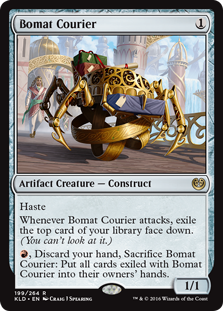 Unlike other one-drop options, Bomat requires no setup: it's always just Bomat. The artifact operates independently from the graveyard, letting us dedicate our remaining creature slots to heavy-hitters Goyf and Mandrills. Doing so proved challenging with delirium in the mix, and fatal in the face of Rest in Peace.
Unlike other one-drop options, Bomat requires no setup: it's always just Bomat. The artifact operates independently from the graveyard, letting us dedicate our remaining creature slots to heavy-hitters Goyf and Mandrills. Doing so proved challenging with delirium in the mix, and fatal in the face of Rest in Peace.
The one-power Bomat Courier doesn't pressure via damage, but via card advantage. Leaving the Construct unchecked results in us drawing multiple cards for a low mana investment, a mechanic that has historically broken tempo decks. Unlike a niche combat keyword like deathtouch, every opponent cares to some degree about card advantage from our deck, since we've got everything in there: reach, permission, and of course, more threats. So they're all incentivized to remove Courier.
As a bonus, Courier boasts two subtypes. Chasing a dead Delver with Tarmogoyf has long been Temur Delver's bread and butter, but burying Courier further grows the Tarmogoyf. Courier's multiple types similarly make delving easier, as fewer cards in the graveyard provide more types.
The Haste Factor
 I consider haste the most busted of Magic's evergreen mechanics. Creatures differ from sorceries by having casters wait a turn before using them, so ones with haste essentially come with an attached Time Walk. Bomat Courier makes use of the keyword by sniping planeswalkers, providing value in the face of removal, and drawing us out of tight spots.
I consider haste the most busted of Magic's evergreen mechanics. Creatures differ from sorceries by having casters wait a turn before using them, so ones with haste essentially come with an attached Time Walk. Bomat Courier makes use of the keyword by sniping planeswalkers, providing value in the face of removal, and drawing us out of tight spots.
First, the planeswalkers. Liliana of the Veil once presented an enormous hurdle for Temur Delver shells; she would come down, eat our creature, and then force a Lightning Bolt or simply chew through our hand and board. Bomat takes out a freshly minused Lili no-questions-asked, all while generating board presence in the form of a must-answer threat. The same applies for other minus-to-one walkers like Chandra, Torch of Defiance and Teferi, Hero of Dominaria.
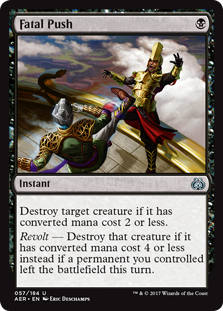 As any Delver player knows, removal-heavy opponents don't waste much time in killing our early threats; that turn one Delver is liable to immediately draw the Push from an opponent's opener. Haste at least gives us one damage for our trouble. I've even found many opponents unwilling to burn removal on turn one Bomat, letting us rack up a few more points before dealing with the Construct.
As any Delver player knows, removal-heavy opponents don't waste much time in killing our early threats; that turn one Delver is liable to immediately draw the Push from an opponent's opener. Haste at least gives us one damage for our trouble. I've even found many opponents unwilling to burn removal on turn one Bomat, letting us rack up a few more points before dealing with the Construct.
Finally, haste bails us out of bleak topdeck situations. In a simplified game state, drawing Bomat and swinging not only presents a threat, but locks in a two-for-one. Opponents then topdecking a removal spell can burn it on our artifact, sure, but Courier replaces itself by then. Of course, they've got no choice; if they wait, we'll set up an even more threatening card advantage engine. Every ensuing turn they whiff on removal represents another card we'll draw when they find it.
These three dimensions granted by haste give Bomat Courier a close Temur analog in Snapcaster Mage, whose combination of flash and flashback performs similar legwork. Of course, Snapcaster ups our mana curve significantly, which interferes with Faithless Looting and the Delver gameplan in general; it also forces us into a more reactive role, while Bomat increases our aggression. And a deceased Snap does half as much for our living Tarmogoyfs!
Other Effects
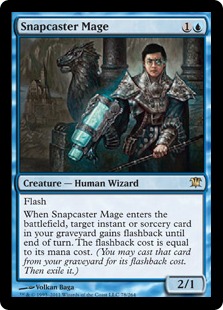 Bomat's inclusion has had other subtle effects on the deck's playstyle. Our long-game improves relative to with Snapcaster, since Bomat runs away with a win unanswered. The cards drawn also let us make our land drops more comfortably without giving up the spares in hand for Looting.
Bomat's inclusion has had other subtle effects on the deck's playstyle. Our long-game improves relative to with Snapcaster, since Bomat runs away with a win unanswered. The cards drawn also let us make our land drops more comfortably without giving up the spares in hand for Looting.
Incremental damage from sudden Bomat attacks contributes to burn-fueled victories, too, in a similar vein to Bolt-Snap-Bolt. And the Construct's costing colorless mana greatly eases the pressure on our manabase; an otherwise useless Forest or Island can now produce board presence, helping us leave up R as Bomat insurance.
Finally, our cantrips sequence differently now, and optimal sequencing patterns shift more throughout games than they did previously. Fetch (to ensure we have access this game to our single Stomping Ground, Mountain, or Forest), cast Bomat, attack and exile, and then Serum before making our other pays is a common early-game sequence. With more lands in play, we might Serum before swinging with Bomat to generate a two-part Preordain, using Bomat to access a scried card on our opponent's turn or in our second main phase.
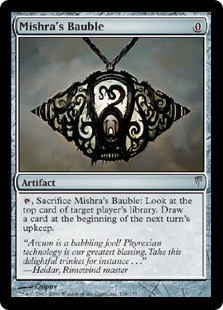 Co-Stars
Co-Stars
Accommodating Bomat Courier pushed me into novel deckbuilding territory, a fact reflected by Miracle Bo's card choices. Here's an explanation of what else made the cut.
Mishra's Bauble
Mishra's Bauble has three well-known applications in Temur Delver decks:
- Grow Tarmogoyf/enable delirium/support delve
- Give a second chance at flipping Delver of Secrets via upkeep trigger stacking
- Hide cards from targeted discard/Liliana of the Veil by cracking on opponent's turn
In Miracle Bo, its uses are more varied. Noah Walker has spoken on Bomat Courier's interactions with Legacy cantrips, and Bauble also supports the Construct in unintuitive ways. We can peek at our top card with Bauble and attack with Bomat to get rid of it before casting a cantrip. Or we can cantrip first to make sure we have access to it next turn. Or fetch before attacks to keep that card in the deck.
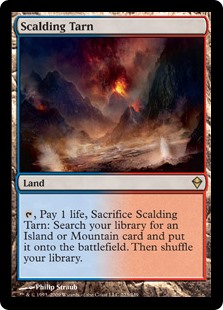 More devious still, seeing something like another creature might make us want to swing with Bomat to exile that creature for later. When opponents force us to crack the Construct, we'll have another creature to replace it with. Similarly, Bauble helps us look for critical cards to tuck, like Stubborn Denial against combo decks. Should we see something useless, like a land, we can fetch that card away before attacking.
More devious still, seeing something like another creature might make us want to swing with Bomat to exile that creature for later. When opponents force us to crack the Construct, we'll have another creature to replace it with. Similarly, Bauble helps us look for critical cards to tuck, like Stubborn Denial against combo decks. Should we see something useless, like a land, we can fetch that card away before attacking.
Whether to tuck a good or bad card depends on two factors: how likely we think Bomat is to die when we can't or don't want to crack it, and how likely we are to have mana available to cash in its body at the right moment. Both factors require planning a few turns ahead and closely monitoring the game state.
Lastly, Bauble's known synergy with fetchlands becomes denser with more cantrips in the mix. If we need a threat or removal spell this turn cycle, we can peek before fetching and fire off a cantrip first should we see what we need. Serum Visions also doubles as Preordain with Bolt or Denial; Bauble can then look at our opponent's card, and we'll have the scried instant on their turn. With Faithless Looting instead of Serum, it's usually best to Bauble first, fetch or not, and then Loot, giving us the juicy cards right away—but not if we're out of mana for the turn cycle.
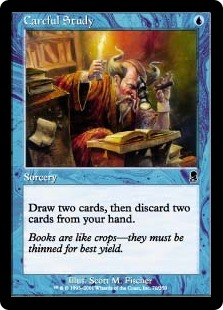 That's a lot of possible options without a blanket "correct" sequencing pattern. Rather, the ideal order of operations for Bauble depends wholly on a pilot's goals in a given situation. It's subsequently quite challenging to extract maximum value from the cantrip in each game, especially without in-deck experience—my Miracle Bo Baubles have significantly improved since last week. Those marginal gains add up fast over the course of games, matches, and certainly tournaments.
That's a lot of possible options without a blanket "correct" sequencing pattern. Rather, the ideal order of operations for Bauble depends wholly on a pilot's goals in a given situation. It's subsequently quite challenging to extract maximum value from the cantrip in each game, especially without in-deck experience—my Miracle Bo Baubles have significantly improved since last week. Those marginal gains add up fast over the course of games, matches, and certainly tournaments.
I will say that overall, Bauble's better early on, when we have more ways to interact with the scry at our disposal. As a topdeck, the artifact drops way off, and is regularly Looted away for something immediately impactful.
Vapor Snag/Dismember/Tarfire/Forked Bolt
This removal package started as 4 Vapor Snag, 2 Forked Bolt. I knew I wanted most of my removal to be single-use and easy to throw around. Snag would take care of the bigger threats, while Forked gunned down 1/1 blockers to make way for Bomat. A Forked was eventually replaced by Mutagenic Growth after the first copy so impressed me in that role, and two Snags were later swapped out for Dismember and Tarfire, in that order.
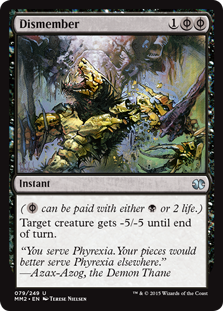 Our manabase is painless enough for Dismember, which can be binned to Looting when it's dead. Tarfire is mostly an extra early removal spell for the small blockers we don't want to Snag. The combination of growing Goyf and firing at instant speed give it the nod over another Forked.
Our manabase is painless enough for Dismember, which can be binned to Looting when it's dead. Tarfire is mostly an extra early removal spell for the small blockers we don't want to Snag. The combination of growing Goyf and firing at instant speed give it the nod over another Forked.
I like holding up Steam Vents to disrupt creature combos, cast Denial, or crack Bomat, and found Forked Bolt's sorcery card type cumbersome at times. It's still nice to have access to the one copy for blowouts, which I've found surprisingly simple to set up.
Mutagenic Growth
Mutagenic Growth fills a few roles for us. Its most obvious application is with Insectile Aberration, where it does a Mental Misstep impersonation against Lightning Bolt; halting damage-based removal also extends to sweepers like Pyroclasm and utility cards such as Electrolyze 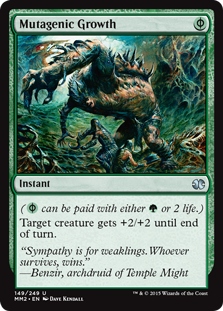 or Collective Brutality from the opponent, even when Delver's unflipped. This role is what I initially recruited Growth for in Counter-Cat, where it remains a staple for saving both Delver and Wild Nacatl at no mana cost.
or Collective Brutality from the opponent, even when Delver's unflipped. This role is what I initially recruited Growth for in Counter-Cat, where it remains a staple for saving both Delver and Wild Nacatl at no mana cost.
Miracle Bo lacks Wild Nacatl, but all its other creatures still benefit from Growth: the trampling Hooting Mandrills becomes especially nasty as a 6/6, and Tarmogoyf gets to swing into his defected brethren unperturbed.
Then there's Bomat Courier, the primary catalyst for a return to Growth. I found that even with a wealth of one-mana removal, the battlefield sometimes clogged enough for Bomat to have trouble attacking. Chief offenders on this front include Memnite, Thalia, Guardian of Thraben, and Lingering Souls.
Mutagenic makes mockeries of these situations. Opponents are almost sure to block the 1/1, and if they do, Growth acts as a 0-cost removal spell for their creature. And that's without mentioning the other creatures opponents throw in front of Bomat, like Devoted Druid; those blocks become a huge liability once they're hip to the Growth plan. Of course, if opponents don't block, we lose nothing and can simply execute our gameplan as normal.
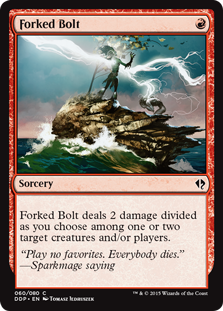 Since Growth doesn't tax us mana, it's the ideal answer to these kinds of boards, even beating out red removal. We can spend that extra mana on chasing the combat phase with Tarmogoyf or making other proactive plays. And since Growth costs 0, we can chain cantrips pre-combat seeking it; Serum into Looting gives us a whopping five looks before we take to the red zone.
Since Growth doesn't tax us mana, it's the ideal answer to these kinds of boards, even beating out red removal. We can spend that extra mana on chasing the combat phase with Tarmogoyf or making other proactive plays. And since Growth costs 0, we can chain cantrips pre-combat seeking it; Serum into Looting gives us a whopping five looks before we take to the red zone.
Growth's mana cost enables tricks with Bomat Courier before the damage step, too. It's not uncommon to swing with Bomat and then crack it after opponents lock in a block, and we've locked in a card. Should Courier have a Growth under it, that instant can be used no matter our mana situation to win another fight this turn.
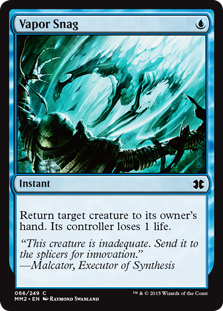 One of Growth's more passive effects is complicating enemy decision trees, as playing around the card requires different lines than our other combat spells do. Say opponents have two 1/1 Spirit tokens and we swing with Bomat. Should they single-block, they open the door for us to remove a token and keep the card under Bomat, only to attack again next turn for an overall net of two cards. Double-blocking prevents that from happening, but also opens them up to a blowout from Mutagenic Growth, killing both their tokens and leaving us with Bomat.
One of Growth's more passive effects is complicating enemy decision trees, as playing around the card requires different lines than our other combat spells do. Say opponents have two 1/1 Spirit tokens and we swing with Bomat. Should they single-block, they open the door for us to remove a token and keep the card under Bomat, only to attack again next turn for an overall net of two cards. Double-blocking prevents that from happening, but also opens them up to a blowout from Mutagenic Growth, killing both their tokens and leaving us with Bomat.
Similarly, I've had payers throw multiple 3/4 Goyfs in front of Mandrills in hope of still trading with the Ape should I have Growth; Vapor Snag on a Goyf let me cleanly trade for one without losing my beater. Growth's very presence keeps opponents guessing throughout the game, and forces them into lines they can never know are wrong until it's too late.
Faithless Looting
Including narrower cards in an aggro-control deck requires an analysis of balance: how much does the card do for the strategy? How often will it be dead or lackluster? The upside of Mutagenic Growth in Miracle Bo seems higher than it does in Counter-Cat, but Bo's Growths are likelier to be dead in general, since they save Wild Nacatl from Bolt, but not Courier.
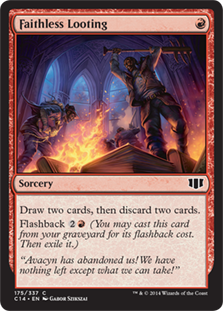 That and similar quirks are mitigated by Faithless Looting, which cycles through the wrong half of the deck to string together its impressive micro-synergies. By that same token, Looting lets us pack plenty of Stubborn Denials, as we can just dump them in the absence of a ferocious enabler; conversely, in the combo matchups that reward multiple Negates, Looting tosses away our Snags and Bolts to power out Mandrills and locate Denial at once.
That and similar quirks are mitigated by Faithless Looting, which cycles through the wrong half of the deck to string together its impressive micro-synergies. By that same token, Looting lets us pack plenty of Stubborn Denials, as we can just dump them in the absence of a ferocious enabler; conversely, in the combo matchups that reward multiple Negates, Looting tosses away our Snags and Bolts to power out Mandrills and locate Denial at once.
Enabling Hooting Mandrills without Thought Scour, a far inferior cantrip in a deck so likely to tap out, is but one of Faithless Looting's additional benefits. It also buffs Tarmogoyf into a ferocious threat. Combined with Mishra's Bauble and a fetchland, Looting imitates Ponder, and mimicks Preordain with Serum Visions (Serum draws and scries; Looting gets us the found cards) and even Brainstorm in the mid-game (by exchanging unneeded cards for new resources).
 A trick long employed by my GRx Moon decks, this "Brainstorm mode" of Faithless Looting incentivizes Miracle Bo to avoid making land drops after the third. Looting turns those spare lands into business. Longer games usually call for a fourth land drop, which allows us to flashback Looting and cast a one-mana spell in the same turn cycle. So does an industrious Bomat Courier; the Construct excels when we dump our hand, and also when we can reliably hold up R to crack it. Looting helps find what we need to empty our hand for Bomat, i.e. dumping conditional permission spells for lands and threats we can play immediately. A turn or two later, it resets our Bomat draws by filtering past the less exciting cards hidden by the artifact.
A trick long employed by my GRx Moon decks, this "Brainstorm mode" of Faithless Looting incentivizes Miracle Bo to avoid making land drops after the third. Looting turns those spare lands into business. Longer games usually call for a fourth land drop, which allows us to flashback Looting and cast a one-mana spell in the same turn cycle. So does an industrious Bomat Courier; the Construct excels when we dump our hand, and also when we can reliably hold up R to crack it. Looting helps find what we need to empty our hand for Bomat, i.e. dumping conditional permission spells for lands and threats we can play immediately. A turn or two later, it resets our Bomat draws by filtering past the less exciting cards hidden by the artifact.
Stubborn Denial
Speaking of narrower cards, here's an instant that's actually dead against a handful of Modern decks. But that's what Faithless Looting is for. The rest of the time, Denial's a brutally efficient counterspell that handles many of Miracle Bo's problem-causers (sweepers; heavy-duty removal; planeswalkers) as well as the win conditions in a slew of linear combo decks.
I tried Spell Pierce in this slot, and even a split, but found Denial a more reliable way to secure a board advantage.
Sideboard
I tend to build highly transformational sideboards that attack opponents from multiple angles. The sideboard has always played a crucial role in Temur Delver, and this time around's no different.
Blood Moon
 Recently successful Temur Delver decks have foregone Blood Moon altogether for the cheaper Tron-beater, Damping Sphere. But I still like Moon's applications against Modern as a whole, as well as its low opportunity cost in a deck with 4 Faithless Looting.
Recently successful Temur Delver decks have foregone Blood Moon altogether for the cheaper Tron-beater, Damping Sphere. But I still like Moon's applications against Modern as a whole, as well as its low opportunity cost in a deck with 4 Faithless Looting.
Triple Moon ensures we almost always have it by three mana if we want to, letting us shape our hand to punish opponents who fetch greedily. Should they grab basic lands, we can dump the enchantment to Looting, growing Tarmogoyf up to 7/8!
Mana Leak
Mana Leak is still a superb counterspell in many matchups, and one of our key cards: Tron, Valakut, and Ad Nauseam are all hopeless without it, and great with. As with Moon, I run 3 because I always want to see it in those matchups. But it's such a liability against most decks that I don't want it in the main. So far, I haven't missed Leak in Game 1; our mainboard isn't configured to ever hold up two mana regardless.
Huntmaster of the Fells/Hazoret the Fervent
Huntmaster of the Fells typically plays double duty in my Temur decks by providing an additional sticky threat against midrange while serving as wincon-in-a-can against small creature decks. Then big story here is Hazoret the Fervent, which joins Huntmaster as a curve topper that comes in against a variety of opponents.
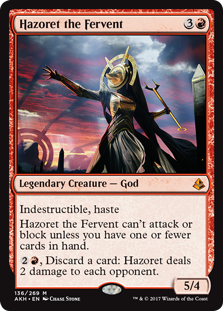 While Bomat shines at killing minused walkers, Hazoret smashes the plussed ones, i.e. Teferi, Hero of Dominaria. Black midrange decks have almost no ways to deal with the God, and white control shells are forced to spend their Paths on our green creatures, meaning they ramp us into four mana. Hazoret ends up being great against pretty much anyone looking to interact.
While Bomat shines at killing minused walkers, Hazoret smashes the plussed ones, i.e. Teferi, Hero of Dominaria. Black midrange decks have almost no ways to deal with the God, and white control shells are forced to spend their Paths on our green creatures, meaning they ramp us into four mana. Hazoret ends up being great against pretty much anyone looking to interact.
Faithless Looting makes its attacking condition hyper-meetable, and keeps Hazoret from clogging our hand. While we can loot the God away if needed, we usually just end up dumping everything else, since casting Hazoret is so game-breaking.
Ancient Grudge/Destructive Revelry
I cut a Grudge halfway through my testing to have outs to enchantments in the deck. Destructive Revelry comes in against lots of opponents, including UWx decks with Detention Sphere or Runed Halo and even Burn, where it hits Eidolon of the Great Revel as well as the odd Ensnaring Bridge. The incremental damage from Revelry plays nice with small points stolen by Bomat, and all our card selection helps us get to the one-of as needed.
Firespout/Anger of the Gods/Engineered Explosives
I love Pyroclasm, but it kills too many of our creatures for me to be comfortable running it. By contrast, Firespout provides a much-needed third point of damage against Humans while letting us surgically manipulate the 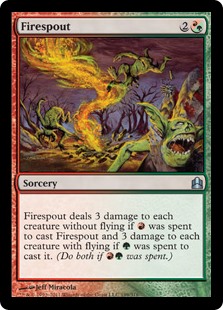 battlefield. The sweeper outs boards of Lingering Souls tokens for Bomat Courier to continue attacking, or cleans up a gaggle of growing Humans while Delver chows down in the air. The added versatility of sometimes not wanting to hit ground creatures makes Firespout a welcome addition to the Bomat build.
battlefield. The sweeper outs boards of Lingering Souls tokens for Bomat Courier to continue attacking, or cleans up a gaggle of growing Humans while Delver chows down in the air. The added versatility of sometimes not wanting to hit ground creatures makes Firespout a welcome addition to the Bomat build.
The Anger of the Gods split follows the same logic as the Revelry split, and hedges against Hollow One's recursive threats. Anger also deals with Dredge, the increasingly popular Bridgevine decks, and the odd Kitchen Finks. Double red is natural to achieve in this deck, but this sweeper still has to contend with Firespout. It's still possible I just want another Spout here.
Engineered Explosives is a card I haven't omitted from my Delver shells for over a year. In Temur, it answers Tarmogoyf and even enables blowouts on boards we wouldn't otherwise beat. Above all, it's supremely flexible.
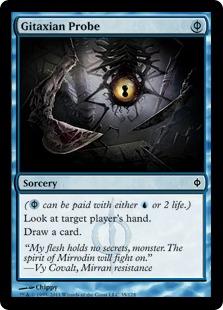 I Ain't Mat at Cha
I Ain't Mat at Cha
Wizards may have inadvertently crippled Modern Miracle Grow analogues when they banned Gitaxian Probe. But I can't help but smile at where the archetype's heading. Between my own promising experiments with Bomat Courier, CHAUGHY's recent results with Noble Hierarch, and Jeff Hoogland's 13-0 with a UR shell at SCG Indy, I'm starting to feel like the sky's the limit for the Human Insect that could. And his little dog, too!


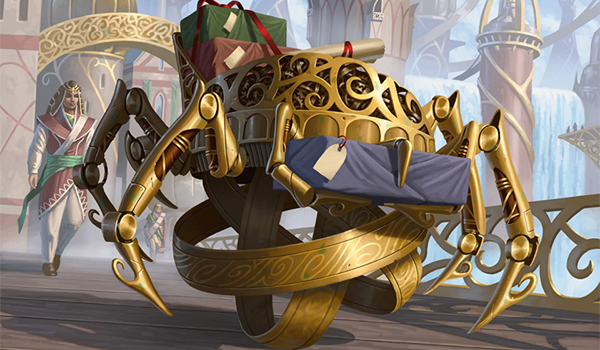


What do you think about bomat in other delver shells like grixis or jeskai?
Does less overall but fine I guess? In Grixis I’m not sure you can justify Delver over Shadow, and in Jeskai, over control.
I’ve been justifying the old grixis delver deck for a while now, mainly due to the local pptq people loving their burn and zoo decks, so the extra life saved is actually incredibly helpful, as is the flying when it comes to closing. Grixis delver is still a totally fine deck choice, but if i were going to something like a GP, i’d probably switch to shadow due to the faster closing speed. The delver version plays the better K command snapcaster mage value game, but sometimes getting ran over by hollow ones makes that a moot point, so i’d prefer a 6/6 or 8/8 deaths shadow in that environment. I wouldn’t ride the deck off just yet.